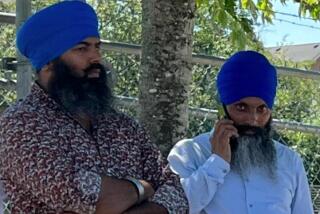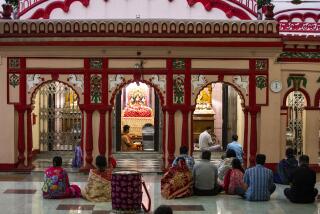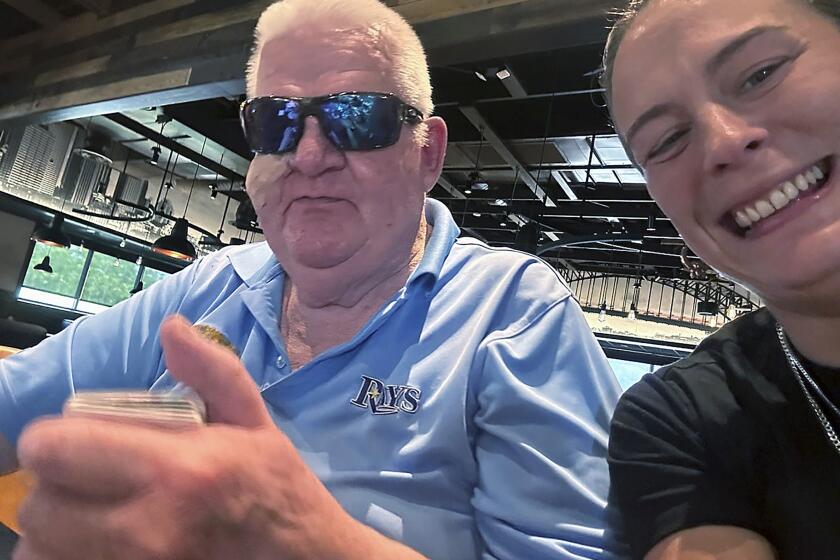Violence by Sikh Separatists Escalates in Punjab
KAURA NIDHAN, India — Writing 30 years ago, British historian Arnold Toynbee described the robust and fiercely unified Sikhs of the Indian Punjab as the ultimate survivors.
“They are the burliest men on the face of the planet, tough and capable and slightly grim,” Toynbee observed. “If human life survives the present chapter of men’s history, the Sikhs, for sure, will still be on the map.”
Toynbee had no way to predict that by 1988 Sikhs would be killing each other in record numbers, that Sikhism’s holiest place, the Golden Temple in Amritsar, would be in the hands of heavily armed fundamentalist separatists who frightened away thousands of less fanatic worshipers, and that a huge Hindu population, after centuries of coexistence and even intermarriage with Sikhs, would feel alienated and vengeful against their former brothers.
The divided, endangered state of Sikhism was never in clearer evidence than in this tiny village in the amber grain-growing lands of Punjab state near the Pakistan border on a recent windy afternoon.
Youth Survives Attack
The night before, Sikh terrorists proclaiming themselves to be members of the Khalistan Commando Force, had killed Sikh farmer Jaswant Singh, his pregnant wife, his mother, his two sisters, one of his nephews and his four small children, who ranged in age from 5 years to 15 months. Another nephew, Dalbir Singh, 15, survived the attack and told the story from his hospital bed in nearby Amritsar.
He said that the killers, accusing the family of betraying the Sikh cause by serving tea and sweets to police officers, had herded him and the 10 other family members into the center of the mud-walled compound and opened fire with AK-47 assault rifles.
On the morning after the killings, the bodies were taken to a nearby city for a police inquest. And on this afternoon, they were returned in a tractor-drawn produce wagon to the compound, where they were met by a mournful chorus of relatives.
As each body was carried from the wagon and placed on a woven jute cot and covered with ice to preserve it for cremation, female relatives slapped their thighs and wailed in a form of mourning known as syapa.
To the Sikh farmers of this region, syapa represents unfathomable grief and a kind of cosmic bewilderment that seems to hover over the 16 million population of Punjab like a “bitter god”--the meaning in Punjabi of the name of this tiny hamlet near the Beas River.
Goal of Independent State
The killing of the family was another graphic sign that Sikh separatists, pursuing their vague, politically unlikely goal of an independent Sikh theocracy called Khalistan (“Land of the Pure”) in Punjab, have escalated a campaign of terror and retribution against civilians as well as government forces.
The killers and most of the victims in the campaign are Sikhs, members of a 500-year-old religion that extols bravery and martial skills but that also has difficulty condemning violent acts if they are done in the name of “protecting the faith.”
Many of the victims, like the Jaswant Singh family, were accused of collaborating with police and security forces.
A leader in the Khalistan Commando Force denied his group’s participation in the killings in Kaura Nidhan.
“We do not make a sport of killing women and children,” said Mulkiat Singh Ajnala, 26, a self-described lieutenant general in the commando organization who was interviewed in a room of the Golden Temple in Amritsar. Ajnala’s brother and brother-in-law have died in battles with police, and surrounding him as he was interviewed were a dozen Sikhs armed with various weapons, ranging from pistols to Chinese-made AK-47 rifles.
Council Condemns Killings
On Thursday, the Council of Khalistan, another Sikh militant organization based in the Golden Temple, condemned the Kaura Nidhan killings and “the self-styled generals who did them.”
Police authorities in Amritsar assert that there is no doubt about the connection of Ajnala’s organization to the massacre.
“They did the thing, and they don’t have the moral courage to own up to it,” said Sarbdeep Singh Virk, deputy superintendent of police.
According to one of several conflicting accounts in the village, Jaswant Singh, 34, had served tea and sweets to police officers at the wedding of his sister 10 days before the massacre.
A note left by the killers charged that Jaswant Singh had acted as an informer to police, who had recovered a car stolen by the Khalistan Commando Force from a nearby farm.
A third source insisted that the killings were committed by terrorists acting for profit, hired by another family as part of a longstanding feud.
Whatever the reason, the killings are ultimately connected to the escalation of violence by the separatists.
685 Killed in 3 Months
In the first three months of this year, 685 people have been killed in terrorist attacks in Punjab, India’s richest agricultural state and a key strategic zone on its frontier with Pakistan. Last year, a total of 1,250 were killed in such attacks.
Thirty-five of this year’s killings occurred Thursday night alone, prompting Prime Minister Rajiv Gandhi to order Punjab police to take new and stronger action in an effort to stem the violence. Gandhi also ordered new police alerts in five states that adjoin Punjab.
In addition to the growing number of terrorist killings, Superintendent Virk reported that 25 gun battles between extremists and police occurred during March.
“It is a warlike situation,” Virk said. “They fire at us, and we fire back.”
The rising violence, including several cases where separatists for the first time have used rocket-propelled grenades, has increased pressure on Gandhi’s government to take a much harder line against the Sikh militants. Hindu fundamentalists have urged the prime minister to send the army into the state.
And for the first time since a disastrous army raid in June, 1984, which ultimately led to the assassination of then-Prime Minister Indira Gandhi, there is renewed talk of an army attack on the Golden Temple, where militants have taken refuge and assembled an arsenal as they did four years ago.
Fears Army Action
“The present government strategy is not a move to solve the problem,” said Harkishan Singh Surjeet, a leader of the Communist Party of India-Marxist here in Punjab and a veteran political figure in the state. “They have reserved themselves emergency powers. I fear they are going to send in the army.”
Even militants inside the temple, who carry their rifles under blankets when they walk on the white marble walks, say they expect an army action.
“We have AK-47s,” one youth bragged. “We have rocket launchers we got from the moujahedeen (guerrillas fighting in Afghanistan). If the army comes, we are ready.”
In June, 1984, Indira Gandhi ordered the army into the temple. In the battle that followed, according to government reports, at least 83 soldiers and 493 civilians, including fundamentalist Sikh leader Jarnail Singh Bhindranwale, were killed. More fatefully, a key building inside the temple grounds, the Akal Takht, was seriously damaged. Damage to the temple was given as the motive for Gandhi’s assassination in October, 1984, by two of her Sikh bodyguards.
The Golden Temple is as precious to Sikhs as the Kaaba shrine in Mecca is to Muslims.
Gesture of Reconciliation
So far, Gandhi has not yielded to pressure to repeat his mother’s tactic. In a gesture of reconciliation in early March, he ordered the release of 40 Sikh inmates of a jail in Jodhpur, where they had been held since the 1984 temple raid. Jasbir Singh Rode, a nephew of slain Sikh separatist leader Bhindranwale, was among those freed.
But in a recent meeting with newspaper publishers and intellectuals, Gandhi went out of his way to stress that he had no intention of negotiating with the Sikh militants.
Also, with the full backing of his Congress-I Party, Parliament approved an emergency constitutional amendment granting the government special powers to deal with the Punjab crisis. President Ramaswami Venkataraman signed the bill into law in spite of protests from opposition leaders who argued that it dangerously increases the central government’s power.
The key to the government policy for Punjab state is ultimately electoral.
Gandhi must call parliamentary elections for the nation sometime in the next 20 months. Because of India’s huge majority Hindu population, increasingly alienated by the Sikh militants, the political value of a hard-line policy on Punjab increases as election time draws near.
Moderate Sikh leaders are concerned that election pressure will provoke the prime minister into an action that will further isolate the Sikhs, who represent less than 4% of the electorate.
Political Motive Seen
“This government, instead of defending national unity, is using the Punjab problem to rally the Hindus for election purposes,” said Harkishan Singh, the Punjabi Communist leader, whose party has lost 24 activists to Sikh terrorists.
“The Congress party used the Sikh card in the last election (in 1984),” said Jagjit Singh Aurora, a retired army general who sits in Parliament as a member of the Sikh Akali Dal Party. “I think they will try to use it again in the 1989 election.”
Aurora and other moderate Sikh leaders fear that unless some concessions to the Sikh cause are won now, they will be lost in a flood of Sikh-baiting as elections near. The effectiveness of attacking Sikhs as a way of gaining attention was demonstrated recently when Bombay political leader Bal Thackery stirred a furor by suggesting a boycott of Sikh businesses until terrorism stops in Punjab.
Some Sikhs Oppose Idea
Although most of India’s 16 million Sikhs live in Punjab, at least 7 million, a majority of them bitterly opposed to the Khalistan movement, live in other states.
But the main victims of the separatists’ terrorism campaign and the political manipulations that surround the whole problem are the people of beautiful, fertile Punjab state.
In recent months, the highly audible mourning rite of syapa has been increasingly heard in the Punjab countryside.
The 5-year separatist campaign has turned this rich, once-robust territory--a land with energy and zest unrivaled in the rest of India--into a solemn, paranoid place.
On most roads, particularly here near Amritsar, bastion of the separatists, traffic stops after dark. Stores close their shutters at 7 p.m. The fear was evident recently in the eyes of a small shopkeeper in the village of Naushera Bannwa on the road between Amritsar and Firozpur.
A traveler stopped to buy a package of cigarettes. Smoking is forbidden by orthodox Sikhism, and the separatists have warned shopkeepers against selling cigarettes.
“I will sell you these cigarettes,” the shopkeeper said, “but for God’s sake do not smoke them until you get in your car. You can leave in your car, but I have to stay here and face the terrorists.”
More to Read
Sign up for Essential California
The most important California stories and recommendations in your inbox every morning.
You may occasionally receive promotional content from the Los Angeles Times.










